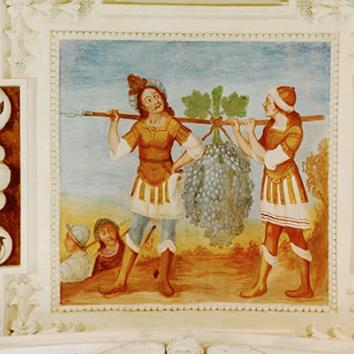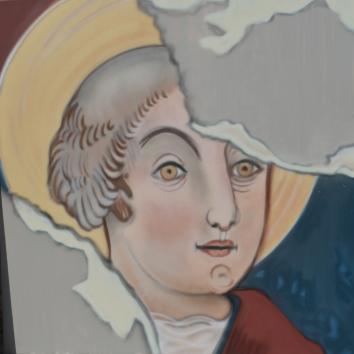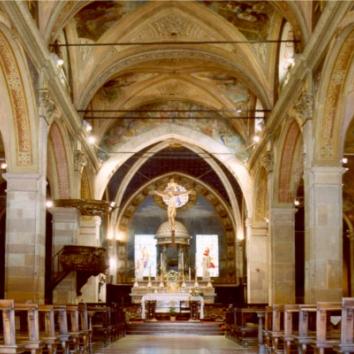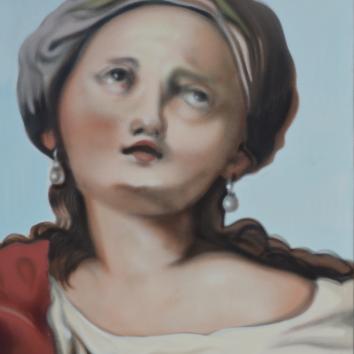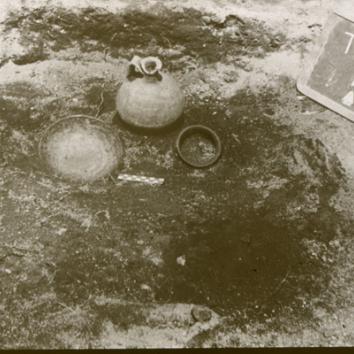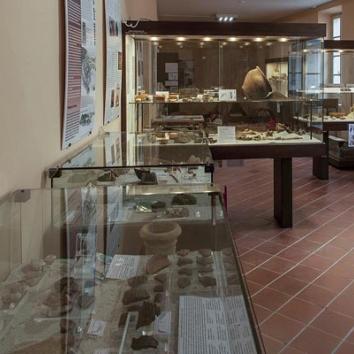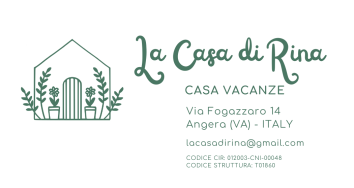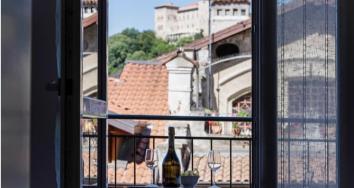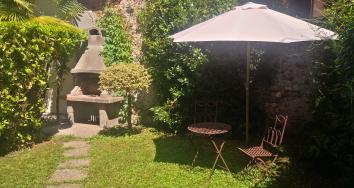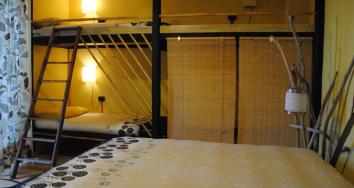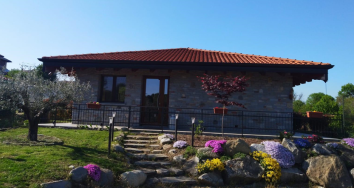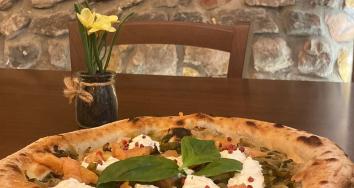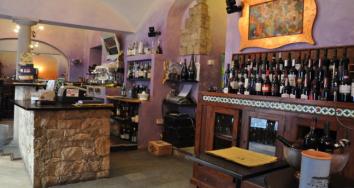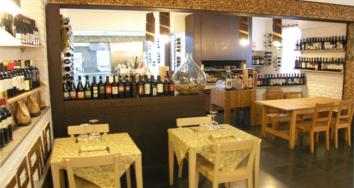Saint Michael Chapel
19th century
The beautifully carved slab, probably of late 19th century date, shows St Michael, winged, dressed in a short light tunic and ankle-length footwear with open toes; he holds the spear firmly in his hands with the point downwards, destined to pierce the winged dragon that the archangel holds firmly under his right foot. The sculptural representation of this monstrous animal perhaps does not do justice to its satanic ferocity.
The chapel is located towards the end of Via San Martino, on the west side of the street, just before the abandoned industrial premises of the Soara (now Solvay group) Magnesia Factory. In this area probably stood the church of San Michele, a zone mainly devoted to farming, and a destination for devotional processions.
Until several decades ago processions of the faithful seeking divine protection of animals and crops could often be seen in the countryside; these numerous religious festivals are recorded in old documents.
Calendar of rites to protect the countryside
Since at least 1605, if not before, at the request of the Angerian community, on January 7th and 8threligious festivals were celebrated for the Three Wise Men, protectors of the fruits of the countryside, as well as kings, magicians and astrologers who were among the first who paid tribute to Jesus. According to tradition, their remains were sent to Milan in the 4th century due to the intervention of Helen, the mother of Emperor Constantine, and placed in the church of Sant'Eustorgio; from there the cult spread throughout the diocese. In 1162 Frederick Barbarossa stole them and took them to Cologne.
On January 17th was celebrated in ancient times the feast of St Anthony Abbot, also called St Anthony the Great or of the Desert; he was an Egyptian hermit who lived for over 100 years in the 3rd and 4thcenturies, and is considered the founder of Christian monasticism. Saint Anthony was reputed to be a great miracle-worker, capable of curing terrible illnesses, and gave his name to the Hospital Brothers of St Anthony dedicated to the care of the sick. Angera Hospital is also part of the hospital named after St Anthony.
In the medieval period it was customary to raise a pig for donation to the sick cared for by the monks of St Anthony; these animals enjoyed the protection of the saint and the community. This seems to have been the origin of his role as protector of domestic animals; his most widespread representation shows him accompanied by a pig. On the saint's feast day in Angera too the blessing of the beasts was held, organized by peasants in the church square. Thus it was hoped that the saint would protect both beasts and people from epidemics. Holy Mass was also celebrated in the church of Sant'Antonio, which was located in Via Paletta, more or less where today there is a gate with a pillar in Angera stone decorated with a rose, similar to those found in the parish church. After its demolition, some of the furnishings were taken to the rectory. One of the most significant works is a beautiful painting showing the saint, an old man, with not a pig but two oxen at his feet; in his hands St Anthony holds a book of the Holy Scriptures on which there is a flame: this fire recalls the saint's protection of the illness 'St Anthony's fire','that takes his name.
The Blessed Sacrament could also help to protect the fruits of the countryside, and thus the community of Angera committed itself to paying for candles and incense to perform this rite on April 16th each year.
The major litany, or rogation, was traditionally a penitential procession to propitiate the harvest and was celebrated on April 25th in the period in which the corn ears begin to form. This tradition seems to have originated in Roman times: Latin writers, including Pliny the Elder, Varro, Ovid and Columella, describe celebrations held for the god Robigus and goddess Robigo, malignant personifications of wheat rust (a disease caused by a fungus). The rituals were celebrated from the 31st day after the equinox for four days and involved the sacrifice of a dog and a ram, with the aim of avoiding the formation of rust. The dog sacrifice was perhaps based on the connection of this animal with infernal deities such as Robigo, or on the fact that Sirius, the "Dog Star", appears in the sky when the hot season begins, which threatens to ripen the crops too early. St Gregory the Great described this custom in the 4th century; the April 25thcelebrations ended up Christianizing a pagan rite widely observed in the countryside. In Angera on April 25th, St Mark's Day, the Santissimo Sacramento and Santa Marta confraternities held a religious procession that set out in the morning from the (no longer extant) church of San Martino in Ranco, and crossed the countryside towards Sesto; the provost then celebrated the benediction in a chapel near where the old church of San Pietro had once stood. It continued towards Uponne, where the participants stopped at the frescos of the Madonna del Carmine and del Rosario, visible in the Pedroli farmhouse, before continuing to the Ranco church, where a “Penitential Mass” was held.
Also on 25th April the blessing with water of San Gemolo of Ganna was celebrated. The saint was a nephew of a bishop north of the Alps who, around the year 1000, set out for Rome. During a stop in Val Marchirolo the bishop was robbed of his horse; Gemolo pursued the thieves but was beheaded by them. God's love for the boy was revealed by the miracle that followed: Gemolo picked up his head, recovered the horse and returned to the bishop at a gallop. In the presence of his uncle he died and was buried, and since then marvellous events have taken place on his tomb, including the appearance of a miraculous spring. A small chapel was built to accommodate worshippers. In Angera sprinkling with the water of San Gemolo took place at the end of the procession of the Great Litany. The miraculous water was collected to pray to the Lord to grant rain in moments of particular drought.
Angera's Capitulary Diaries also recount that on 26th June a Holy Mass was celebrated for Santa Eurosia, another singular figure: her story takes us from Angera to Spain. Tradition has it that the martyr came from Bohemia and was promised in marriage to the Spanish Count of Aragona. In 880 she crossed the Pyrenees to meet her future husband. On the mountains the party was attacked, but the girl refused to yield to the brigand chief, who had her hands and feet cut off; she nevertheless continued praying to heaven and was finally beheaded. Then a great storm broke out, with rain, wind, lightning and thunderbolts. Her ability to calm bad weather is recognized; the saint is invoked against lightning, hail and more generally for the health of the countryside and the harvest. As well as in Spain, her cult is widespread in northern Italy, especially in areas once under Spanish rule. In addition to Angera, she is also venerated in Taino and Vergiate. The Mass dedicated to her in Angera was a donation of the Borromeo family; the diaries also refer to the display of her relics, of which all memory has been lost.
During certain years a ceremony to encourage rain was also held on 26th July and 5th September, using water from the San Quirico cistern, which was sprinkled after a religious procession to Prato delle Ossa.
For the preservation of the fruits of the countryside, and the preservation of life from every accidental danger, prayers were also said to San Vincenzo Ferrer, of Spanish birth, who untiringly preached for peace and church unity and became Pope in 1455. On these occasions a portrait of him was carried in procession to San Quirico, to bless the whole area from on high; this was perhaps the painting preserved in the rectory, which shows him with a crucifix in hand and a flame on his head, a sign of his evangelism.










